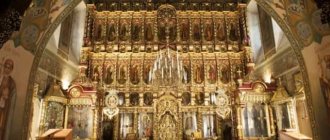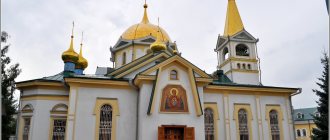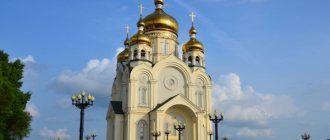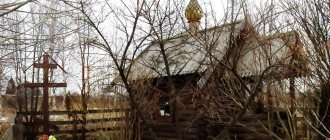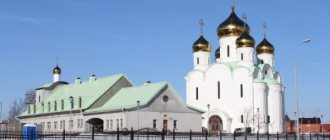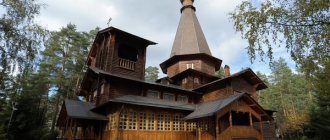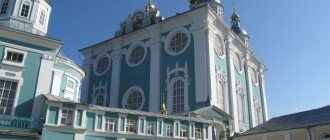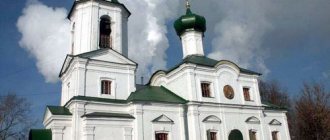Many say that Petropavlovsk is surprisingly similar to another church, the Church of the Savior on Spilled Blood, built where Alexander II died at the hands of revolutionary terrorists. The similarity is not only external: it turned out that the construction of this building began in the year when the last Russian sovereign ascended the throne, who, several decades later, was also destined to die.
Cathedral of the Holy Apostles Peter and Paul in Peterhof
Peter and Paul Cathedral in Peterhof today
The temple is located on the shoreline of Olga Pond on the territory of New Peterhof (St. Petersburg Avenue) near the legendary architectural creation “Peterhof”. Today, the rector of this holy place is Archpriest Mikhail Teryushov.
The Cathedral of Peter and Paul in Peterhof received its name in honor of the supreme apostles - the most famous disciples of Christ the Savior, who, thanks to their ardent service to God, received respect in the Christian environment.
The temple consists of several chapels that are dedicated to Peter and Paul, Ksenia of Milass, Alexander Nevsky and Ksenia of Petersburg. Nowadays, the church is a place of cultural heritage of the Russian Federation at the regional level and is recorded in the appropriate register.
Olympics and perestroika
Only in 1974, on the initiative of the Society for the Preservation of Monuments, the cathedral was recognized as a historical and architectural monument and taken under state protection. Then the gradual renovation of the temple began. The approach of the 1980 Olympics played a role - in anticipation of many foreign guests, it was necessary to polish the appearance, show the safety of architectural monuments, and demonstrate care for them. According to this concept, the cathedral was restored only from the outside - all five domes were restored and gilded, and crosses were erected on them with the help of helicopters. The interior of the temple remained untouched by the restorers - they were waiting for the authorities to decide what the former main cathedral of Peterhof would now become - a museum or a concert hall.
And for the third time in its century-long history, the delay of the authorities brought benefit to the temple: while this issue was being resolved (or, rather, lying under the carpet), the era of perestroika began. In 1989, encouraged by the solemn celebration of the 1000th anniversary of the baptism of Rus', the believing residents of Peterhof asked for the return of the Cathedral of Peter and Paul to the Russian Orthodox Church - and received a positive response. Over the next five years, the interiors of the temple were restored, and on July 9, 1994, the revived Peter and Paul Cathedral was re-consecrated.
History of foundation, construction, whose idea
In 1892, the emperor received an appeal to begin the construction of a temple in Peterhof, which would be able to accommodate many ordinary parishioners within its walls. The initiator of the message turned out to be Protopresbyter John Yanyshev at that time. Alexander III held a competition among architects and ultimately chose the design of Nikolai Sultanov in 1893.
And a few months later, preparations for construction began: a deep pit was dug, sheds and an engineer’s house were erected. The foundation stone of the Peter and Paul Cathedral in Peterhof was laid on August 6, 1895, and Vasily Kosyakov was appointed project manager.
After only 4 years, the main building was erected, and after another 3 years, finishing work was carried out, space heating and a ventilation system were installed. At the last stage of construction, the iconostasis was installed, the temple was painted, and a park was planted. During the same period, a school, a boiler house and an electrical station were built at the church.
On June 25, 1905, the cathedral was sprinkled with holy water. The imperial couple was present at this event. Additionally, the premises of the chapel named after Joseph the Songwriter were also attached to the temple, which was destroyed a little more than half a century later. In 1938 they wanted to blow up the building, and 3 years later the decoration of its domes was destroyed.
The cathedral was severely damaged during the war, but already in 1974 it was transferred to the care of the state.
In 1987, restoration work was completed, after which in 1989 the building was returned to the structure of the church, and a year later new repairs began: the basements were drained, electricity and water supplies were restored, and the courtyard was cleaned. On June 9, 1994, the shrine was consecrated by Alexy II.
Soviet authority
After the Bolsheviks came to power and published the decree on the separation of church and state, the need for God's presence began to be challenged. Baptism, confession and communion became optional. Church wealth was confiscated. Workers at the FTK-1 plant more than once demanded the destruction of the temple, which reminded everyone passing by of humility and repentance. The following circumstances prevented the demolition of the shrine:
- technical impossibility of removing debris and debris after destruction;
- The cathedral was a maritime landmark and was located at all sailing directions.
Of the thirty churches in Peterhof, all were closed except for the chapel in the cemetery. The houses of God housed apartments, warehouses and shops.
The restoration of the temple began only thirty years after the war. The reconstruction was led by Evgeny Sevastyanov. On April 9, 1974, scaffolding was built around the cathedral. Restoration has begun. In 1980, with the help of a helicopter, crosses were installed on the temple. The city needed a temple, and man needed God.
In 1994, the Cathedral was consecrated by Patriarch Alexy II. At the same time, the first service after many years was held. Orthodox life was being revived.
Architect, exterior decoration, architectural ensemble
The Peter and Paul Cathedral was built in the format of Russian architects of the 16th-17th centuries. The building is designed to accommodate 800 people at a time. In Peterhof, this building is one of the tallest - 70 m. Externally, the church has a shape similar to a pyramid, topped with 5 tent-shaped domes. Wall cladding made of red and yellow bricks.
On the facades were placed images of holy people - protectors of the family of heirs to the throne. The building itself is surrounded by a closed gallery equipped with specialized rooms for performing the rite of consecration.
All 4 entrances to the building have canopies for storing outerwear. The facades located on the sides are equipped with flights of stairs for the choir. Two porches, a bell ring, and a chapel are attached to the main entrance.
Modern life of the cathedral
After the restoration, the original appearance and architectural features were completely restored. The temple was defended according to all the canons of Russian architecture, which were observed by architects of the 16th and 17th centuries. According to Sultanov’s idea, the structure was supposed to resemble a pyramid and have 5 hipped domes with domes.
Red and yellow bricks were used for the exterior decoration. The walls were decorated with sandstone columns, clay tiles and frescoes. The facades of the building are decorated with icons depicting saints who patronized the imperial family.
Around the temple there is a glassed-in gallery for religious processions. The cathedral itself has 4 entrances, each of which has a canopy for outerwear. The main entrance has 2 porches, a hipped belfry and a chapel.
Inside the cathedral there is a confessional booth and a funeral chapel, the first to the east and the second to the west of the northern wall. The iconostases of the Church of Saints Peter and Paul deserve special attention. The main one is made of majolica in the likeness of the iconostasis of the Church of St. George in Venice.
Interior of the cathedral
The interior of the cathedral received its decoration thanks to the icon painters Safonov and Kolupaev. The main iconostasis was built following the example of the Church of St. George, located in Venice. In the center of the building inside, a silver crucifix was installed in an arch.
Peter and Paul Cathedral, Peterhof inside.
The iconostases of the chapel, as well as the side chapels, were made of Carrara marble. The images themselves were painted by the artist Guryanov. The confessional is located in the northeast of the building, and the chapel for the dead is in the northwest.
Architecture and decoration
The cathedral was built in the forms of Russian architecture of the 16th-17th centuries. Designed for 800 people.
Externally, the temple has a pyramidal shape and is crowned with five hipped domes. Its height is about 70 meters.
The walls, lined with dark red and light yellow bricks and glazed tiles, are decorated with sandstone columns and tiles. The apses are decorated with blind columnar arches.
On the facades were placed icons of saints - patrons of members of the imperial family.
The cathedral is surrounded by a covered gallery, in which there are special rooms for the blessing of eggs, Easter cakes and Easter. At each of the four entrances, a canopy for outerwear was designed. On the side facades there are stairs to the choir. At the main entrance there is a hipped belfry, a chapel and two porches. The entrance to the chapel is decorated with an arched portal made of planked stone.
In order to illuminate the interior of the tents, windows were made. They are currently used for tourism purposes, as the windows offer beautiful views of the surrounding area: St. Petersburg, Babigon, Kronstadt and others. There is a gallery between the tents.
The main chapel was consecrated in the name of the holy chief apostles Peter and Paul; the southern aisle is in the name of St. Xenia the Roman; the northern aisle is in the name of the holy noble prince Alexander Nevsky. In 1990, the chapel of Blessed Xenia of St. Petersburg was built.
The interior painting was done by Palekh icon painters and Moscow masters N.M. Safonov and V.I. Kolupaev.
The main majolica iconostasis was modeled after the iconostasis of the Greek Orthodox Church of St. George in Venice. In the center, on a wide tibla in a large arch, there was a silver Crucifix with those in front.
The iconostases of the chapels and chapels were made of white Carrara marble. The images for the iconostasis were painted on bronze boards by V. P. Guryanov.
A confession booth was set up in the northeastern part of the temple; in the northwestern one there is a “chapel for the dead.”
There were only two burials in the chapel of the cathedral - Major General Dmitry Fedorovich Trepov (1855-1906), over whose grave there was a marble tombstone, and his wife Sofia Sergeevna Trepova, who died in 1915. At the end of the 1930s, their burials were opened by the authorities, and the remains were taken to an unknown location (a saber was taken from D. F. Trepov’s coffin).
Clergy and mentors
Over the entire period of the cathedral's existence, several priests served within its walls.
Their list is given in the table:
| date | Confessors |
| summer 1905 – autumn 1906 | Nalimov V.A. |
| autumn 1906 – autumn 1918 | Dyakonov M.A. |
| autumn 1918 – winter 1919 | Hieromonk Nikolai |
| spring 1934 - winter 1937 | Goremykin I. F. |
| 1938—1989 | The temple was closed |
| winter 1990 - spring 1990 | Victor I.G. |
| spring 1990 - summer 1990 | Kuryanov S. |
| autumn 1990 - summer 1991 | Kochmaruk A. |
| summer 1991 - winter 1992 | Kovalchuk G.V. |
| winter 1992 - summer 1996 | Fortunatov V.A. |
| summer 1996 - 2013 | Kudryashov A.V. |
| 2013—autumn 2017 | Kudryashov P.A. |
| fall 2021 - present | Mikhail Teryushov |
Social work and everyday life today
The Peterhof Church of Peter and Paul leaves no one in trouble. A special social worker works here two days a week, whose task is to provide assistance to people who find themselves in difficult life situations for various reasons.
Young people are also given close attention and the Angelos club is open for them. In addition, work is regularly carried out with those who have just begun their journey in Orthodoxy or are beginning to look for their way to the temple. For this purpose, there is always at least one priest in the cathedral.
Every Saturday during the Divine Liturgy, only amateurs sing, and everyone can take part in this chant.
Worship services and other visiting opportunities
The doors of the temple are open to all those who suffer at any time of the day. Every Saturday a Divine Liturgy is held, in which only non-professional singers sing. Anyone can take part in it.
There is also a schedule of events for each day:
- 9:00 - confession;
- 9:30 — Divine Liturgy;
- 17:00 - evening service.
Sunday School
Literally 100 years ago, the holy youth Tsarevich Alexy suffered martyrdom, which is why he was canonized. For many young people today, his faith, courage and humility are an edifying example.
About 60 children attend Sunday school at the Cathedral of Peter and Paul, and they are taught in three age groups. The classes themselves are held from 12.30 to 16.00 every Sunday.
Training takes place in the following disciplines:
- Holy Bible.
- Fundamentals of Orthodox teaching.
- God's Law.
- Church choir.
- Art studio "Obraz".
- Theatre studio.
Also, every Saturday from 19.30 to 21.00 classes are held for adults, led by Archpriest John. The post of school director is occupied by Elena Vladimirovna Repina.
Patronal holidays
The Cathedral of Peter and Paul in Peterhof is a place where the memory of several saints is revered.
Therefore, the following holidays are celebrated in the temple:
- January 29 – Worship of honest chains.
- February 6 – Venerable Xenia of Milas.
- June 5 – Cathedral of Saints of Rostov and Yaroslavl.
- July 6 – Cathedral of Saints of the city of Vladimir.
- July 7 – Cathedral of St. Petersburg Saints.
- July 12 – Peter and Paul.
- July 13 – 12 apostles.
- September 12 – Transfer of relics from Vladimir to St. Petersburg.
- December 1 – Council of Saints of the Estonian Land.
- December 6 – Burial in Vladimir at the Nativity Monastery.
The luxury and beauty of the Church building of the Grand Palace
Initially, the interiors of the Church building amazed visitors to the temple with its pomp and luxury.
Here the ideas of Orthodox church construction were embodied together with Western forms in the Baroque style. Large windows provided a constant flow of light, and the abundance of gold and bright colors in paintings and images attracted the eyes of the most sophisticated viewers. Among other things, Elizaveta Petrovna wanted to see only beautiful pictures and faces, which in the Church building are distinguished by kind expressions and soft features. There is not a single fresco depicting the Last Judgment or any pictures of hell and dark forces. The atmosphere of the temple was not just blissful and religious, but also festive, which is what the empress wanted. The sacred meaning of the mass of gold decorations and carvings in the Altar, the Hall and the Refectory is known - this is the embodiment of the Glory of God, therefore in the Church building of Peterhof this theme became the main one, along with the kindness and softness of the faces of the apostles, saints, archangels and angels.
Opening hours for visitors
Any Orthodox Christian, or anyone who wants to be baptized in an Orthodox church, can visit the Peter and Paul Cathedral of Peterhof daily, since services are held in this shrine every day. Confession begins at 9 am, and half an hour later the Liturgy begins.
Evening services are held from 17.00. Every Sunday, akathists are also read to Christ the Savior and the Mother of God (alternately), and every Thursday - to Nicholas the Wonderworker and the holy apostles Peter and Paul.
Interesting facts about the cathedral
During the government under the leadership of Stalin, they wanted to demolish the temple. However, since it was one of the most convenient and significant landmarks for navigation, the dismantling of the building was canceled, and officials began to think about its restoration.
It is thanks to this that today the church delights its guests and parishioners. In 1993, the bass bells were donated by the German Bachmann couple from the city of Aachen.
These three cast giants were given names:
- "Holy Spirit."
- "Archangel Michael".
- "The Virgin Mary".
The Cathedral of Peter and Paul in Peterhof is also surprising in that it has a covered gallery and a canopy for clothes, and not every church in Russia can please people with such features. The cathedral has 16 crosses, and the main cross weighs 450 kg.
History of the creation of the temple
Russia in the 19th century was a deeply religious country, so several churches and temples were built in each city.
Peterhof was no exception. The city where the Grand Palace was located needed a temple not inferior to it in beauty and grandeur. The churches that already stood on the territory of Peterhof were small in size and could not accommodate all the believers. Some of them served exclusively for the military or members of the imperial family and their entourage. Mere mortals were prohibited from entering such churches. Therefore, Peterhof was in dire need of a spacious church open to all believers.
When in 1892, Alexander III learned about the petition of the head of the court clergy, Ioann Yanyshev, for the construction of a new temple, he did not hesitate to allocate the most picturesque place for it on the banks of the Olgin Pond. For a whole year, several famous architects participated in a competition for the best construction plan. The winner of the competition was ultimately the talented architect and restorer Nikolai Vladimirovich Sultanov.
In 1894, construction of the cathedral began. Vasily Antonovich Kosyakov was chosen as the main builder. He already had several cathedrals behind him in St. Petersburg and its suburbs. The foundation of the temple was laid by Ivan Yanyshev himself on July 25, 1895. It was completely built and finished in 9 years.
The consecration of the cathedral was scheduled for June 12, 1905, which, according to tradition, was conducted by Protopresbyter John. Members of the imperial family were present at this event. And on August 28 of the same year the chapels of St. Alexander Nevsky and St. Xenia were consecrated. Archpriests Nikolai Kedrinsky and Peter Blagoveshchensky were invited to conduct the rituals.
A chapel erected in honor of St. Joseph the Hymnographer and a green garden around the building were given into the possession of the temple. After the revolution, the Peter and Paul Church was transferred to the status of a cathedral. It operated until 1938, when an order for its demolition was signed.
But the government's plans were not allowed to come true. In 1941, the Great Patriotic War began, which destroyed many priceless architectural monuments. The Cathedral of Saints Peter and Paul was no exception. He lost the northern wall during a siege by a German spotter. After the end of the war, the cathedral premises were used as a warehouse.
Only in 1972 the historical significance of the temple was restored. It was taken under the guardianship of government agencies and was classified as a historical and cultural monument. According to the restoration plan, the cathedral was to become a museum or concert hall. But in 1989 it was decided to leave the building a religious status and preserve its value for posterity.
Construction and foundation
The construction of the building began only a year after the adoption of Sultanov’s project, that is, in 1894. After 4 years, the temple was completely erected; finishing work on the facade and interior took about another 3 years. The painting of the cathedral and the construction of the iconostasis lasted 2 years.
In total, the construction of the Peter and Paul Cathedral lasted for 9 years.
The Peter and Paul Cathedral was consecrated on July 12 (old style) 1905 by the Venerable Father John. The side chapels in the name of Alexander Nevsky and St. Xenia were consecrated later (August 28, 1905) by Archpriests Nikolai Kedrinsky and Peter Blagoveshchensky.
Historical fate
After the Bolsheviks came to power, the Church of Peter and Paul was transferred to the status of a cathedral. The activity of the temple continued until 1938. It was at this time that the order to demolish the cathedral building was signed. However, the Great Patriotic War prevented the implementation of plans to destroy the shrine.
During the war, the church building did not escape its destructive effects. The back of the building was almost completely destroyed. After the end of hostilities, the temple premises were used as a warehouse.
Recovery and reconstruction
Reconstruction of the Peter and Paul Cathedral began only in 1974 and continued for almost 20 years. The work was supervised by Evgeny Sevastyanov. In 1994, the temple was consecrated by Patriarch Alexy II. At the same time, the first service, after many years of oblivion, took place.
Current situation
The Cathedral of Peter and Paul actively participates in the modern life of society. For those who find themselves in a difficult situation, a social worker is ready to help, who sees them twice a week. A clergyman is constantly present in the church building, who gives instructions and advice to parishioners.
The church also hosts a Sunday school, which can be attended by both adults and children. The clergy also work with those who are just looking for the path to God.
Where is it located, what is in the surrounding area, how to get there
The exact address of the cathedral: St. Petersburg Avenue, 32/4, bank of Olgin's pond, Peterhof. The temple rises on the banks of the Red Pond. From the upper windows of the building, which today are used as observation platforms, you can enjoy an amazing view of the entire surrounding area: the Gulf of Finland, Kronstadt, Babigon and St. Petersburg itself.
You can get to the cathedral by taxi or public transport. Not far from the shrine there is a stop called “Trading Square”, on the opposite side of which the temple stands. You can get here by bus No. 200 or 210. Or take buses 344, 351B, 351A, 352, 355, 356, 356B and get off at the Pravlenskaya stop.
Interesting Facts
The cathedral is named after the patrons of Peterhof - the supreme apostles Peter and Paul. They were the most devoted disciples of Jesus Christ, for which they paid with their lives. Every year on July 12, the church celebrates their memory.
According to the plans of the Stalinist government, it was decided to demolish the temple building. But since it was one of the significant landmarks on shipping maps, the question arose about its restoration. Thanks to this fact, today every resident and guest of Peterhof has the opportunity to visit the Peter and Paul Cathedral.
The top of the temple was decorated with a tent covering to give the shape of a pyramid. The room in the tents was illuminated through cut windows. Today they are used as observation platforms that offer amazing views of the expanses of St. Petersburg.
All the utensils of the Peter and Paul Cathedral were made to order by craftsmen. A special requirement was compliance with the strict style in which the entire temple was made.
The architecture of the building, although it was made in the old Russian style, had many innovations. Not a single temple could boast of a covered gallery or vestibule for clothing. If it were not for the large-scale struggle between the state and religion, today we could observe a more modern appearance of church buildings.
The miraculously preserved temple on the shores of Lake Holguin opens its doors to everyone and offers a glimpse into the history and culture of the 19th century.
Information for pilgrims
The basic rules for visiting the cathedral are quite simple and completely echo the Orthodox canons.
They are observed in the following order:
- When entering the temple, be sure to cross yourself.
- Men must take off their hats, women must put them on.
- Clothing must be modest and closed (men are not allowed to enter in shorts and T-shirts, women are not allowed to wear miniskirts or pants).
- It is prohibited to talk during services, use a mobile phone inside the church, or take photos or videos without the permission of the priest.
- Women venerate icons and other sacred objects with painted lips.
Inside the Cathedral of Peter and Paul, parishioners, pilgrims and tourists can purchase various icons, including the apostles. There is also the opportunity to buy crosses, religious literature, and candles. In the immediate vicinity of the temple there are several hotels, among which “Samson”, “Hotel Nadezhda” stands out.
Temple of Alexander Nevsky
In the 30s of the 19th century, a very interesting temple was built that decorated the Kolonistsky Park - the Church of St. Prince Alexander Nevsky, embodied as a neo-Gothic chapel by the architects A. Menalas, I. I. Charmleman, K. F. Schinkel. The place designated by Emperor Nicholas I for the construction of the temple was the Alexandria Park, donated to Empress Alexandra Feodorovna as a country dacha residence. After its consecration in 1834, the chapel became the home church of the emperor’s family and at the same time a beautiful decoration for the park.
The architectural appearance of the chapel is a building with an apse on the eastern side, on which bell towers were installed. Eight spiers topped with Orthodox crosses rise above the temple. On all sides the building is decorated with forty-three sculptures, including images of the Mother of God, apostles, angels and archangels. This work was performed by the sculptor V.I. Demut-Malinovsky. The chapel is also decorated with cast iron in the form of lace. The court artist Timofey Neff created the unique interior decoration of the church, consisting of an iconostasis and stained glass windows. The Romanovs loved to go to church with the whole family, calling it a “small escape.”
The second consecration of the chapel occurred after restoration in 2006, when the ashes of the wife of Alexander III, who arrived from Denmark, were reburied.
